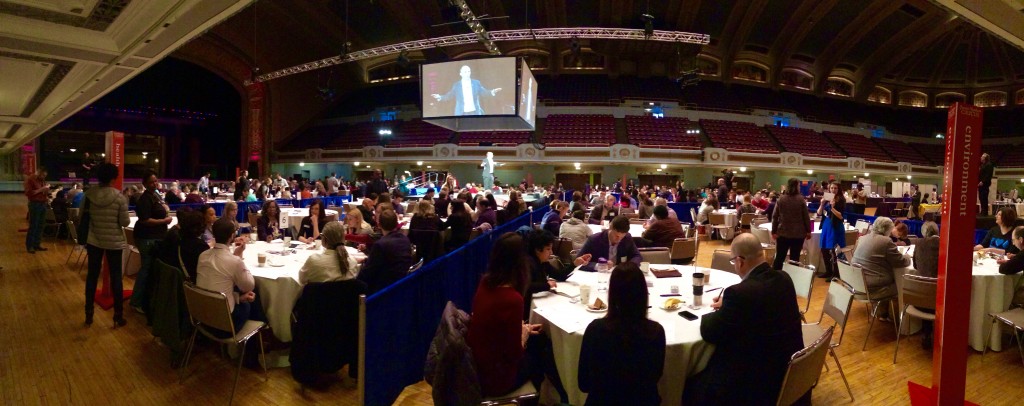Last weekend, the Cleveland Foundation and our partners kicked off the Greater Cleveland Caucus series with the Town Hall Meeting on Community Solutions. More than 400 Greater Clevelanders along with representatives from more than 70 nonprofit organizations discussed the key issues impacting our region.
The goal was to convene Greater Clevelanders and encourage community dialogue on our most pressing issues in eight “caucus areas”: Education + Youth Development, Environment, Health, Housing + Neighborhoods, Inclusion: Population + Demographics, Jobs + Economy, Safety, and Transportation + Infrastructure.
Here’s how it worked:
- Local leaders set the scene with short presentations to frame discussions in each of the eight caucus areas (see brief recaps below).
- Attendees gathered in their chosen caucus area to brainstorm and put forth their top priorities.
- All Town Hall-goers reconvened to vote for the top priority in each caucus area.
The results for each caucus area are in, and winning priorities help crystallize the most urgent need in each area. See the results here.
Highlights from the Caucus presentations:
Education: Eric Gordon, CEO of Cleveland Metropolitan School District, shared the far-reaching benefits to society when more students graduate high school. “We can graduate every kid in Cleveland. We have a moral imperative to do it,” he said.
Environment: Jenita McGowan, Chief Sustainability Officer for the City of Cleveland, outlined the impact of climate change in Greater Cleveland. Cleveland is warming faster than national and global averages and is 25% wetter than 50 years ago. “Investing in Cleveland’s clean energy future helps us be smart about solving our most pressing environmental issues while also improving our economy and quality of life for Clevelanders,” she said.
Health: Dr. Sonja Harris-Haywood, Director of NEOMED-CSU Partnership for Urban Health, spoke of healthcare inequities between urban and suburban populations and the imminent primary care physician shortage. Cleveland has the second highest rate of African-American infant death in the country. “A death of a child is a death of a child, and in some Cleveland communities, many children never get to celebrate a first year of life,” she said.
Housing + Neighborhoods: Erika Anthony, Senior Director of Advocacy, Policy and Research at Cleveland Neighborhood Progress, talked about distressed Greater Cleveland neighborhoods and equity as an economic imperative. “Community and economic development can’t be done in isolation. We can’t solve comprehensive community development if we don’t first identify the systematic and inequitable policies that have led us here today,” she said.
Inclusion: Population + Demographics: Joe Cimperman, Incoming President of Global Cleveland, discussed the value of welcoming immigrants and migrants to Greater Cleveland. The city of Cleveland will receive 1,000 refugees next year. “For every one immigrant that comes to Cleveland, five jobs are created,” he said. “The challenges we face cannot be solved by one people from one nationality. They require all of us,” he said.
Jobs + Economy: Eric Diamond, Executive Vice President of Lending at ECDI, talked about the power of minority entrepreneurs to create jobs and drive our economy. “We need to eliminate barriers between access to capital and the African-American community. We can rebuild neighborhoods one entrepreneur at a time,” he said.
Safety: Ron Soeder, President of Boys & Girls Club of Cleveland, spoke of violence as a public health crisis. 11 of the 94 homicides in Cleveland last year were individuals affiliated with BGCC. “We have a crisis here. I am tired of seeing children killed in Cleveland,” he said. “Every one of us can lift somebody up. Positive connections with adults and mentors is the most important thing we can do as an individual or as a neighborhood,” he said.
Transportation + Infrastructure: Grace Gallucci, Executive Director of Northeast Ohio Areawide Coordinating Agency, cited the $10 billion coming to our region in funding for transportation infrastructure in the next 20 years, to both maintain decades-old transportation decisions and build a modern transit future for Cleveland. “We want everyone to participate in the planning of how we spend those dollars. We need to better consider public transit, bicycle and pedestrian modes of transit to create a truly inclusive system,” she said.
The Greater Cleveland Caucus: A Town Hall Meeting on Community Solutions was just the first in a series designed to foster community engagement. Click here to engage in a future caucus.



